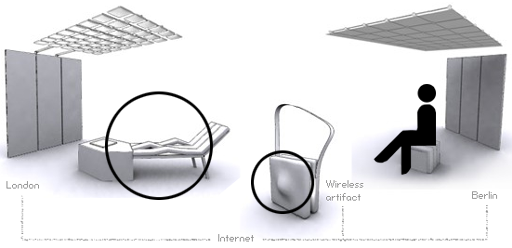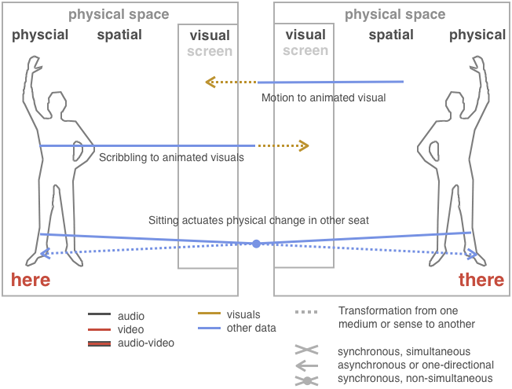Smart Studio “Remotehome“, 2003“Remote home” was created within a period of three months by an interdisciplinary team of practitioners at the Smart Studio / Interactive Institute in Stockholm, Sweden in 2003. The team included Tobias Schneidler (architect/team leader), Magnus Jonsson, Fredrik Petersson (engineers) among others. 
|
|||

Remotehome uses an interesting approach in the way it uses spatiality, artificiality and transportation to connect two remote places with minimal, nonverbal cues. |
|||
Spatiality and Transformation in RemotehomeInteresting from this research’s perspective is that in Remotehome peoples activities in the environment trigger changes in the appearance of everyday artefacts at the remote location. It is playing with the notions of Here and There, yet there is no transportation involved. It is not about going there, but more a mix between a playful intervention and an information display. Some initiation and knowledge is necessary to comprehend the changes happening in the apartments. An uninitiated visitor might think of a haunted house where furniture moves and lights switch on and off without a visible cause. 
|
|||
Transformation and Artificiality in RemotehomeArtificiality is in the case of Remotehome the arbitrary cause (actions) and effect relationship which is also its main conceptual weakness: There is no meaningful relationship between an action and the effect it causes in the remote counterpart. Even when the environmental changes are decoded their semantic meaning stays very dissociated. Bulges in the wall as a result of crossing a room can neither be seen as a deeply connecting experience then a meaningful one. Remothome’s expressions are very abstract while the high artificiality of the code is not necessarily the main problem. The mapping of the sofa interaction principle is clear and direct - yet from a usability perspective not very felicitous. |
|||
ConclusionNote to myself: What makes it telematic? Information art? Global awareness? Dialogical? |
|||
Linkshttp://remotehome.org |
|||
| last update: 3/29/02012 14:29 About Contact Disclaimer Glossary Index |
|||
